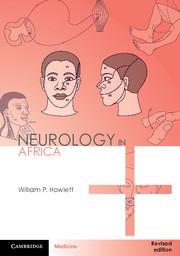Book contents
- Frontmatter
- Dedication
- Contents
- PREFACE
- Acknowledgments
- Part II Neurological Disorders
- 3 Public Health
- 4 Epilepsy
- 5 Stroke
- 6 Neurological Infections
- 7 Protozoal Andhelminthic Infections
- 8 Neurological Illness in HIV Disease
- 9 Coma and Transient Loss of Consciousness
- 10 Paraplegia Non Traumatic
- 11 Disorders of Peripheral Nerves
- 12 Cranial Nerve Disorders
- 13 Myopathies and Myasthenia Gravis
- 14 Movement Disorders and Motor Neurone Disease
- 15 Headache and Facial Pain
- 16 Intracranial Tumours
- 17 Dementia
- 18 Inherited Neurological Disorders
- 19 Head and Spinal Injury
- 20 Care in Neurology
- INDEX
- ABBREVIATIONS
- USEFUL WEBSITES
14 - Movement Disorders and Motor Neurone Disease
from Part II - Neurological Disorders
- Frontmatter
- Dedication
- Contents
- PREFACE
- Acknowledgments
- Part II Neurological Disorders
- 3 Public Health
- 4 Epilepsy
- 5 Stroke
- 6 Neurological Infections
- 7 Protozoal Andhelminthic Infections
- 8 Neurological Illness in HIV Disease
- 9 Coma and Transient Loss of Consciousness
- 10 Paraplegia Non Traumatic
- 11 Disorders of Peripheral Nerves
- 12 Cranial Nerve Disorders
- 13 Myopathies and Myasthenia Gravis
- 14 Movement Disorders and Motor Neurone Disease
- 15 Headache and Facial Pain
- 16 Intracranial Tumours
- 17 Dementia
- 18 Inherited Neurological Disorders
- 19 Head and Spinal Injury
- 20 Care in Neurology
- INDEX
- ABBREVIATIONS
- USEFUL WEBSITES
Summary
Movement disorders occur mainly because of disease of the basal ganglia and its central connections. Drugs may also cause them. They are characterized as those with too little movement or hypokinetic disorders as occurs in Parkinson's disease or with too much movement or hyperkinetic disorders as occur in tremor, dystonia and chorea. The most common overall movement disorder is tremor and the most common major movement disorder is Parkinson's disease (PD). This chapter outlines the main movement disorders and also motor neurone disease. The student should aim to be familiar with their main clinical features and management.
PARKINSON's DISEASE (PD)
Parkinson's disease is a progressive neurodegenerative disorder characterized by four key clinical features: tremor, rigidity, poverty of movement also known as bradykinesia or akinesia, and loss of normal posture with a tendency for falls (Figs. 14.1 & 2). PD occurs all over the world affecting >1% of the population >65 years in high income countries. PD also occurs in Africa but may be less frequent there with lower reported age adjusted prevalence rates of 40–67/100,000. Males and females are both equally affected. PD typically begins in the age group 50–60 years and then occurs with increasing frequency in older age groups. PD may also affect a younger age group <40 yrs (5–10%). Juvenile onset PD (<20 yrs) is usually hereditary and may have more dystonic features than the adult onset disorder.
Causes
The underlying cause of most cases of PD is not known and the term idiopathic PD is used to describe the disease. Many of the clinical features of PD can result from a variety of other conditions including vascular disease, drugs, neurodegeneration and rarely encephalitis. When this happens the condition is called parkinsonism rather than PD.
Pathophysiology
The classic features of PD are a result of degeneration of dopamine secreting substantia nigra neurones which project from the brainstem via the striatal neurones to the basal ganglia. This leads to a loss of the characteristic black pigment and the remaining dopamine secreting cells may show Lewy inclusion bodies. Clinical disease starts when the substantia nigra cell loss is >50% and striatal dopamine levels are reduced by >80%. Recent studies have shown however that the pathology in PD is more widespread and occurring much earlier than originally believed.
- Type
- Chapter
- Information
- Neurology in AfricaClinical Skills and Neurological Disorders, pp. 327 - 348Publisher: Cambridge University PressPrint publication year: 2015



